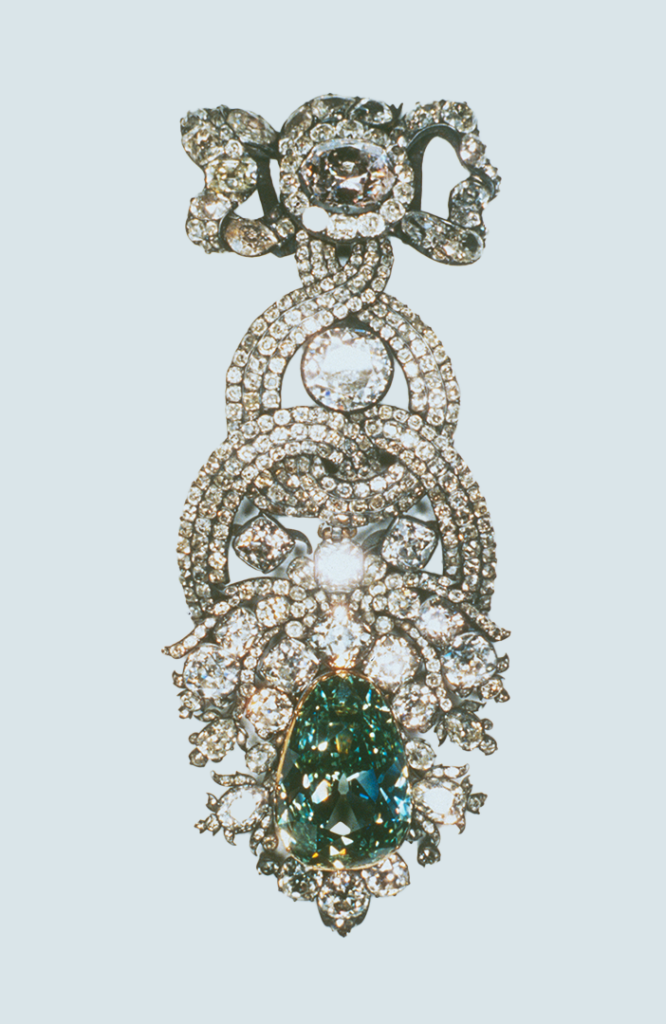One of the rarest diamonds in the world is probably one you’ve never even heard of: The Dresden Green. It’s lived quietly in Dresden, Germany with a couple of side trips that kept it hidden from view and safe from harm’s way.
The Dresden Green, which weighs approximately 41-carats is the largest known natural color green diamond. Much of what we know about the stone comes from an article “The Legendary Dresden Green Diamond” authored by Gemological Institute of America (GIA) gemologists Robert E. Kane, Shane F. McClure and Joachim Menzhausen, published in Gems & Gemology, Winter 1990. The trio of gemologists travelled to Germany and did a complete gemological examination of the Dresden Green diamond. The diamond lives in Dresden, Germany in the Green Vaults, which is the treasury of the Dresden Castle. The Green Vaults were originally created by Friedrich Augustus I, Elector of Saxony and King of Poland, in 1721 as a museum to showcase the wealth and cultural prominence of the area. The palace was pretty much destroyed during World War II, but miraculously part of the Green Vaults survived; they were restored and are once again a museum open to the public.
Unwanted Diamond

The green diamond’s first recorded appearance was in 1726. Details are a bit murky, but historians believe that the gem was brought to Europe, most likely to London, from the Golconda region of India (now known as Hyderabad) by diamond dealer Marcus Moses. Allegedly, the gem was offered to England’s King George I, but he wasn’t interested. Unlike today’s world where colored diamonds are highly coveted, in those days no one recognized the rarity of colored diamonds, they were considered oddities that were not very valuable.
A few years later, the diamond was presented to Friedrich Augustus I, aka Augustus the Strong. He was a known collector, but he too, turned down the gem. Finally in 1741, the stone found a home with Friedrich Augustus II, who was Elector of Saxony and King of Poland as Augustus III. He purchased the pear-shaped stone, which is exceptionally transparent with even color, from a diamond dealer, Delles, at the Leipzig Great Annual Easter Fair. The price paid for the gem is up for debate, with historians noting that the stone sold for anywhere from 60,000 to 400,000 thaler, which are silver coins approximately the size of a silver dollar. Historically, 400,000 is probably accurate as a letter states that when King Augustus was asked for money to pay for heavy artillery by Frederick the Great, King of Prussia, for the siege of Brünn, Augustus was unable to help as he had spent 400,000 thaler for a large green diamond. The purchase of the diamond left Augustus broke.
Setting the Dresden Green Diamond
One year after purchasing the diamond, Friedrich Augustus II commissioned court jeweler Johann Friedrich Dinglinger to set the rock in a Badge of the Order of the Golden Fleece. In 1746, the diamond was reset by Geneva goldsmith André Jacque Pollard. This time, the Dresden Green was paired with the 49-carat Saxon White diamond, the largest white diamond in Augustus’ collection. A favorite of the royal, the stone stayed in the badge for the next several years. Then during the Seven Year war, the jewel was sent to the Königstein Fortress for safekeeping.

When Friedrich Augustus and his son both passed away, the rock transferred to Augustus, 13-year old grandson, also Friedrich Augustus. A few years later, the young Friedrich Augustus had the stone reset in a more stylish hat ornament. The green sparkler is still in that setting.
When World War II struck Europe, the Dresden Green was once again sent to the Königstein Fortress for safekeeping. Dresden was pretty much demolished by bombing, but its namesake diamond remained safe. In 1945, the Russian organization, the Soviet Trophies Commission, took the Dresden Green, along with other valuable objects that had been stored with it, to Moscow. In 1958, all of the items, including the diamond, were returned to Germany. The Dresden Green was put on public display at the Albertinum Art Museum in Dresden along with other items from the Green Vaults in 1959, the first time it had been seen publicly since 1942. The Dresden Green has since graced another museum with its presence. After a one day viewing at New York City jeweler Harry Winston’s Fifth Avenue store, it was displayed alongside the Hope Diamond at the Smithsonian in 2000.
Featured image (top of page): Dresden Castle, photo by Kolossos.
Authored by Amber Michelle
